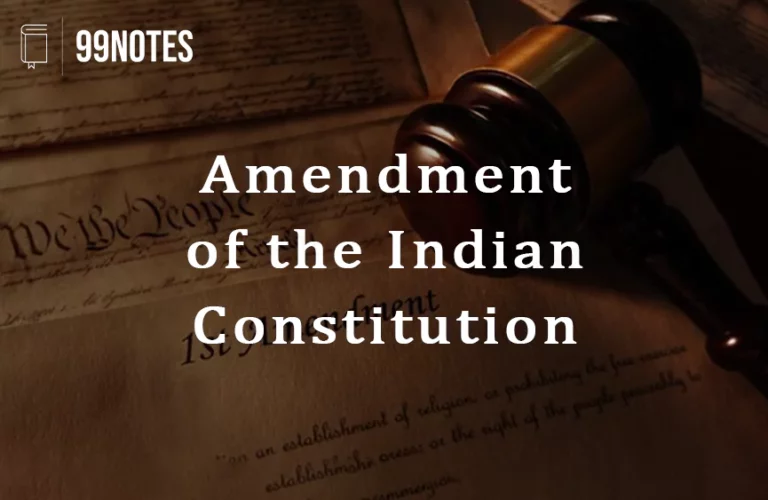Evolution of Indian Constitution
Evolution of Indian Constitution – Historical Underpinnings
Indian constitution came into force on 26th January 1950 after almost three years of hard work by the Constituent Assembly of India. However, the constituent assembly itself did not make it completely fresh. It took the best of the principles and ideas of the world and the already existing Indian laws to form the Indian Constitution.
Thus, it is necessary to understand the historical underpinnings of the Indian Constitution.
Historical Background of the Indian Constitution
The historical background of the Indian Constitution can be found in British rule in the country. The British came to India as traders in 1600 in the form of the East India Company, which had the exclusive rights of trading in India under a charter offered by Queen Elizabeth I.
The British Rule in India mainly came in two phases, viz. Company rule and Crown rule.
- The company rule concluded with the revolt of 1857 (1st War of Independence).
- Thereafter, the Imperial Crown of Great Britain took over the country’s administration.

The historical backdrop of the Indian Constitution and its evolution initiated with the Regulating Act of 1773, which was the first time the British Parliament passed a law to regulate the affairs of the East India Company (E.I.C) in India.
- In 1928, the Lucknow All Parties Conference drafted the Constitution of India, which was also known as the Nehru Report.
- There are various layers in the background of the Indian Constitution. Now we will discuss all of them as they played an instrumental role in developing the Indian Constitution.
The Dual Government System
- After the Treaty of Allahabad (1765) between the Mughal Emperor and the British, the responsibility of governance was laid on the shoulders of the Britishers for the first time in history.
- A system of Dual Government was introduced in Bengal by Robert Clive following the Treaty of Allahabad (1765) after the Battle of Buxar.
- Under the Dual governance system, the British administration acquired both the functions of the Diwani and Nizamat of Bengal.
|
Diwani = Revenue and Civil Administration (acquired from the Mughal emperor) Nizamat = Police and Criminal Administration (Nawab of Bengal) |
Mismanagement during the Dual government phase
Dual governance was a failed experiment due to the following reasons:
- Rampant corruption among the company servants, who used private trading to enrich themselves.
- Excessive revenue collection and oppression of peasantry.
- The Company’s bankruptcy while the servants were flourishing.
To tackle this situation in India, the British Parliament constituted a committee to probe into the Company’s affairs. The report submitted by the committee paved the way for the Regulating Act of 1773 to enforce governmental control and regulate the affairs of the Company.
Regulating Act-1773
This was the first step taken by the British government to regulate and control the Company’s affairs in India. It has not given complete power to the Company hence called a regulating act.
Why was the Regulating Act of 1773 introduced?
- Economic reason: The famine in 1770 affected agriculturists, and revenue collection was so poor that it led them to the brink of bankruptcy.
- Political Reason: To bring Company affairs under Parliament control and put an end to the arbitrary rule of the Company.
- Bad Governance: The system of Dual government was an utter failure.
Thus, the regulating act of 1773 was introduced.
Provisions of Regulating Act, 1773:
- It designated the Governor of Bengal as the ‘Governor General of Bengal’ with an executive council of 4 to assist him.
-
- The act subsumed the presidencies of Madrasand Bombay under Bengal’s control. It laid the ground for a centralised administration in Indian Subcontinent.
- Governor of Bengal designated as the Governor General of Bengal. The majority would make all the decisions, and Governor General could only vote in case of a tie.
- The Governor General of Bengal had a tenure of 5 years.
- Warren Hastings was appointed as the 1st Governor General of Bengal.
- The governance system consisted of the Court of Directors and the Court of Proprietors.
- The Court of Directors’ term increased to 4 years from 1.
-
- 1/4th of them used to retire every year.
- Provision for re-election was Absent.
- 24 of such directors were present.
- Court of Proprietors: This Court of Directors was elected by shareholders of the Company annually. The collective body of these shareholders was calledthe Court of Proprietors.
- Governance of the Presidency was conducted by a Governor and a Council responsible to Home Government.
- The Governor General’s Council had 4 members to assist him. It was made supreme over other Presidencies in matters of war and peace.
- A Supreme Court of Judication was established with 4 judges at Fort William in Calcutta(1774), with appellate and original jurisdictions where all subjects could seek redressal.
-
- The court has both Civil and criminal jurisdiction with original and appellate jurisdiction.
- It was independent of Governor-General in Council.
- Sir Elijah Impey was the 1 st chief justice of the Supreme Court.
- The act prevented Company officials from receiving any cash or gift in kind.
- Made it compulsory to renew Company Charter every 20 years.
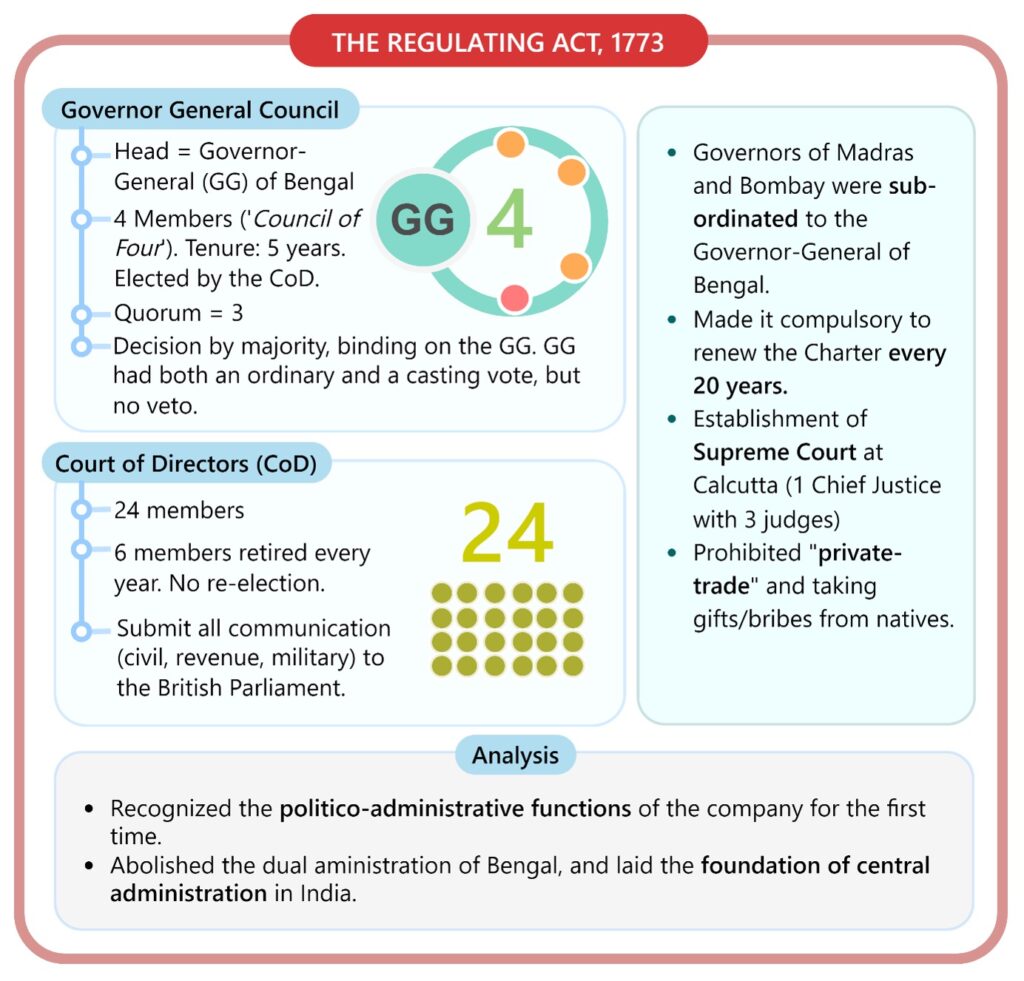
Demerits
- The governor general had no veto power, which meant that there was no mechanism to resolve any deadlock.
- The act made Governor-General in Council powerless, being merely an advisory body.
- The jurisdiction of the Supreme Court wasn’t clearly defined: During 1779-80, the rivalry between the Supreme Court and the Supreme Council (Governor General Council) reached its peak. The Governor General Council then filed a petition against the Bengal Supreme Court’s unlawful activities.
To resolve this issue, a committee was established by the British Parliament to investigate the situation. Considering its report, the Parliament passed the Act of Settlement in 1781.
The Act of Settlement of 1781
Provisions:
- The jurisdiction of the supreme court was defined within Calcutta.
- The servants of the government were unassailable if they did anything while discharging their duties.
- Social and religious usages of the subjects were to be honoured.
Pitt’s India Act of 1784
By enacting this act, the Parliament of Great Britain desired to address the inadvertence of the Regulating Act of 1773 by bringing the East India Company’s rule in India under the control of the British Government.
Provisions:
- It distinguished between the commercial and political functions of the Company.
- This act established a Board of Control of 6 members consisting of the Chancellor of the Exchequer, a Secretary of State, and not more than six members of Privy Counsellors (to be appointed by the imperial Crown) were to exercise control over the Company’s Civil-military and revenue activities.
- Court of Directors retained without any alteration in its composition.
- Reduced the number of Governor General’s Council members from 4 to 3.
- The commander-in-chief was one of the members.
- Governors of Bombay and Madras were made subordinate to Governer General.
- The governor-generalwas conferred greater powers in matters of war, revenue and diplomacy.
Evaluation of Pitt’s India Act
The act was significant for two reasons:
The Act of 1786
- The Amending Act of 1786 was passed by the British Government to invest more power into the Governor-General to override the decision of his Council and act without its concurrence in extraordinary conditions.
- In 1786, Lord Cornwallis was appointed as the Governor-General of India.He had two demands while acquiring the positions. They are:
-
- He wanted to have the powers of both the governor-general and the commander-in-chief.
- Governor-General should be given the right to overturn his Council’s decision in extraordinary instances, and he should be given the power to override his Council’s decision.
- Cornwallis was allowed to override the Council’s decisions. Later, this provision was extended to all the governors-general.
The Charter Act of 1793
The East India Company Act of 1793 passed by the British Parliament renewed the charter issued to the British East India Company.
Provisions of the Charter Act of 1793:
- Increased Centralisation:
- The Governor-General was granted immense powers over the subordinate presidencies of Bombay and Madras.
- The Governor-General’s power of overruling his Council was affirmed.
- When the Governor-General was present in Bombay or Madras, he would supersede in authority over the governors of Bombay and Madras.
- If Governor-General is absent from Bengal, he could appoint, from among the civilian members of his Council, a vice president.
- The composition of the Board of Control was altered. It was to have a President and 2 junior members who were not necessarily members of the Privy Council.
- Trade: The act renewed the Company’s commercial privileges for the next 20 years.
- Senior company officials were obstructed from leaving India without appropriate permission, and leaving India was considered an automatic resignation.
- The Company could, now grant licenses to individuals and company employees to carry on trade in India (also known as the “privilege” or “country” trade). This paved the way for shipments of opiumto China.
- Royal approval: Royal approval was essential for the appointment of the governor-general, the commander-in-chief and the governors.
- Sovereignty: According to the act, the acquisition of sovereignty by the Crown’s subjects is on behalf of the Crown and not in their own right. Further, the Company’s political functions executed were on behalf of the British government. This meant greater British control over the Company.
- Exchequer: The salaries of the staff and the Board of Control were now charged to the Company.
-
- After paying the necessary revenue, interest, salaries, and dividends from the Indian revenues, the Company was to pay 5 lakh pounds per annum to the British government.
Charter Act of 1813
The East India Company Act of 1813 was an act of the British Parliament that renewed the charter issued to the East India Company and continued the Company’s rule in India.
Background:
- In England, the business interests pushed for an end to the Company’s monopoly over trade in India because of a spirit of laissez-faire.
- The Continental System in Europe under Napoleon Bonaparte hurt British businessmen and merchants as it barred the import of British goods into French allies in Europe.
- They thus requested a piece of British trade in Asia and an end to the monopoly of the East India Corporation.
The East India Company obviously opposed such a change.
Provisions:
- End of Company’s Monopoly: The Company’s commercial monopoly ended except for the tea and opium trade and the trade with China.
- The defined constitutional position of Indian territories for the first time – as – regulations made by councils of Madras, Bombay and Calcutta were required to lay before the British Parliament.
- Revenue matters:
-
- The powers of the Board of Control were enlarged.
- Separate accounts were to be maintained regarding commercial transactions and territorial revenues.
- The Company’s shareholders were given a 5% dividend on the revenue of India.
- Christian missionaries were allowed to preach in India.
- Increased Jurisdiction: The act also increased the jurisdiction of Indian province governments and courts over subjects of the British Empire.
- Education: It made funds available to support the resurgence of Indian literature and the advancement of science. A sum of 1Lakh rupees was to be set aside to encourage literature, learning and science amongst natives every year.
This started the inevitable process of dilution of the Company’s power and greater control of the British Government over India.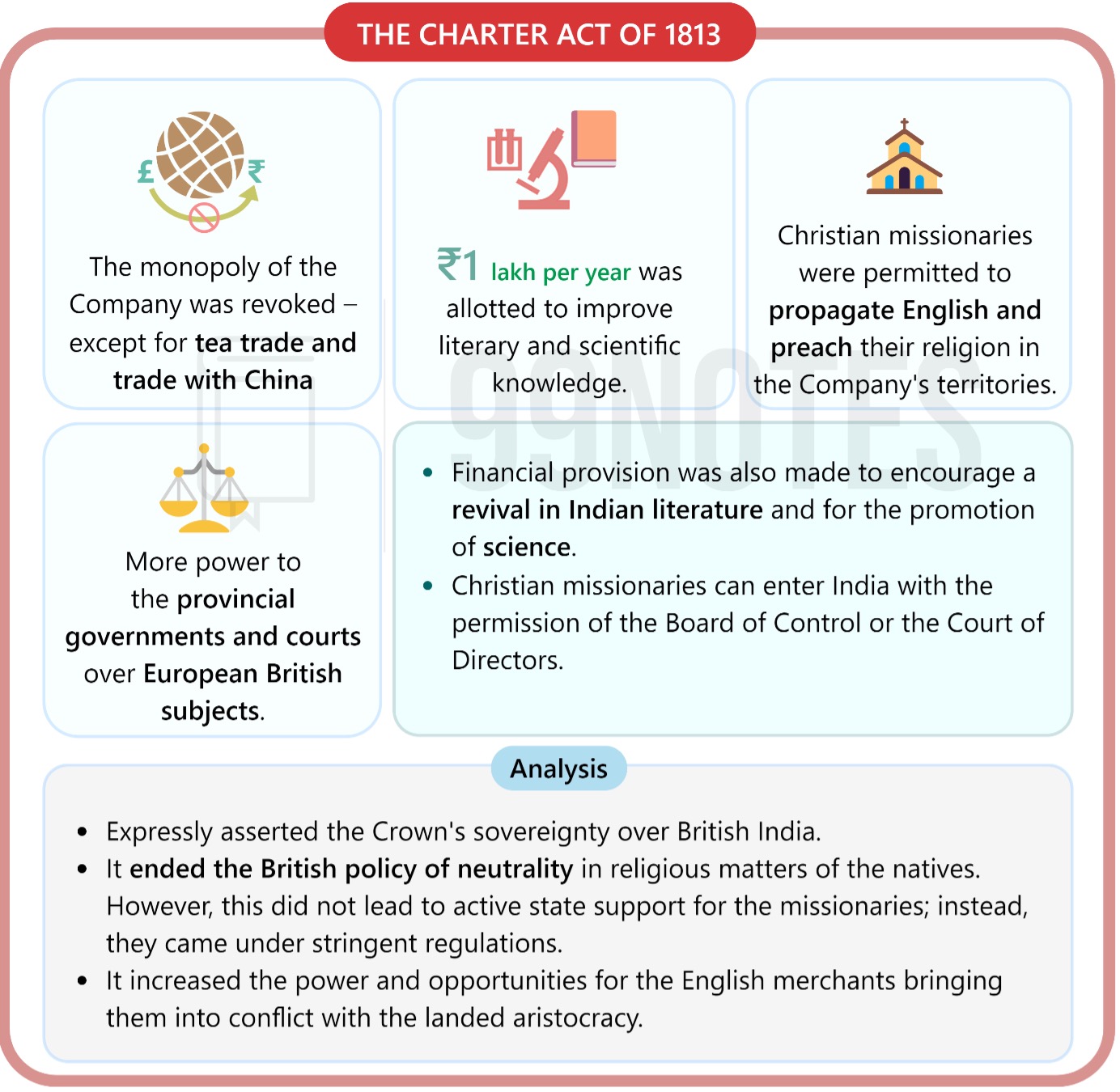
Charter Act of 1833
- The Charter Act of 1833 was an act that extended the East India Company’s charter by 20 years.
- The Charter Act 1833, also known as Saint Helena Act 1833, as this act took away Saint Helena Island from the English East India Company.
Background:
- The Charter Act of 1833 was enacted against the backdrop of important changes that had happened in Great Britain as a result of the Industrial Revolution.
- The liberal movement took place in 1832 in England; in this situation of liberalism and reform, the Parliament was asked to renew the charter in 1833.
Provisions:
- Abolition of Commercial Privileges of the East India Company: The monopoly on tea trade and trade with China was ended.
- Wholesale colonisation: No restriction on European immigration or acquisition of property.
- Centralisation: –The financial, legislative and administrative centralisation took place.
-
- Governor General of Fort William now became Governor General of India.
- He was given superintendence and control over all civil & military powers.
- He had competed for control over finances.
- The governments of Madras and Bombay were deprived of their legislative power and left with a right to propose to the governor-general the projects of law which they thought to be expedient.
- Now rules were called ‘Acts’.
- Formation of Law Commission: A Law member was appointed to the Governor-General’s Council for professional advice. Macaulay was made the first Law member.
- Addressing discrimination in employment: It allowed natives to hold employment and office. Satyendra Nath Tagore became the first Civil Servant Officer in 1864.
- Abolition of Slavery: Steps were taken to ameliorate the condition of slaves, and slavery was finally abolished in 1843.

The charter act of 1833 was the epitome of centralisation, as all the power was now vested in the Governor General of India. He controlled the administration, armed forces as well as the finances. He was responsible only to the British Crown.
Charter Act of 1853
It was the last of the series of charter acts enforced by the British Parliament between 1793 and 1853. It was a significant constitutional landmark.
Background:
- Due to the court of directors and board of control’s attendance, the delivery business has been delayed and overextended.
- The British East India Company had already acquired Sind & Punjab as well as several other Indian states; therefore, there were territorial and political changes in India following the Charter Act of 1833.
- Concerns were also expressed regarding the Governor-General of India’s function as Governor of Bengal because it influences some decisions in Bengal’s favour.
- Decentralisation of power and including the Indians in the running of their own affairs were also demanded.
- The British Parliament agreed to renew the East India Company’s charter in 1853 based on the aforementioned factors.
- The Company appointed 2 Committees to look into the Company’s affairs. Their findings were used to create and pass the Charter Act of 1853
Objective:
The Company’s jurisdiction was restored by the Charter Act of 1853, and it was given permission to hold the properties and income from Indian colonies in trust for the monarch. However, unlike the earlier Charter Acts, this one did not confer commercial privileges for a set length of time.
Provisions: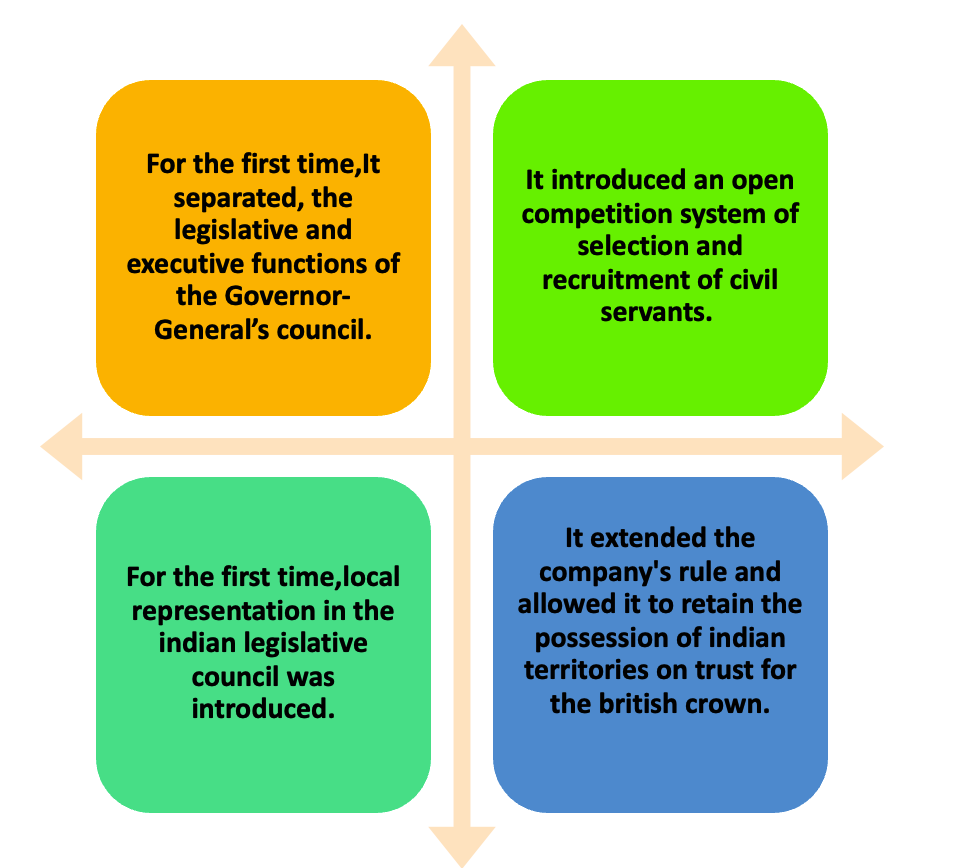
- The civil services were now thrown open to a competitive examination.
- Clear Separation of powers for the first time:
- A legislative Council of 6 members was formed. The Chief Justice of the Supreme Court and a Judge was also a member amongst them. Four other members represented the four Provincial councils – Bombay, Bengal, Madras and Agra.
- Executive Council: The strength of the Council was increased from 3 to 4, as the Law member became a full member of the Executive Council.
- The strength of the court of Directors was also reduced.
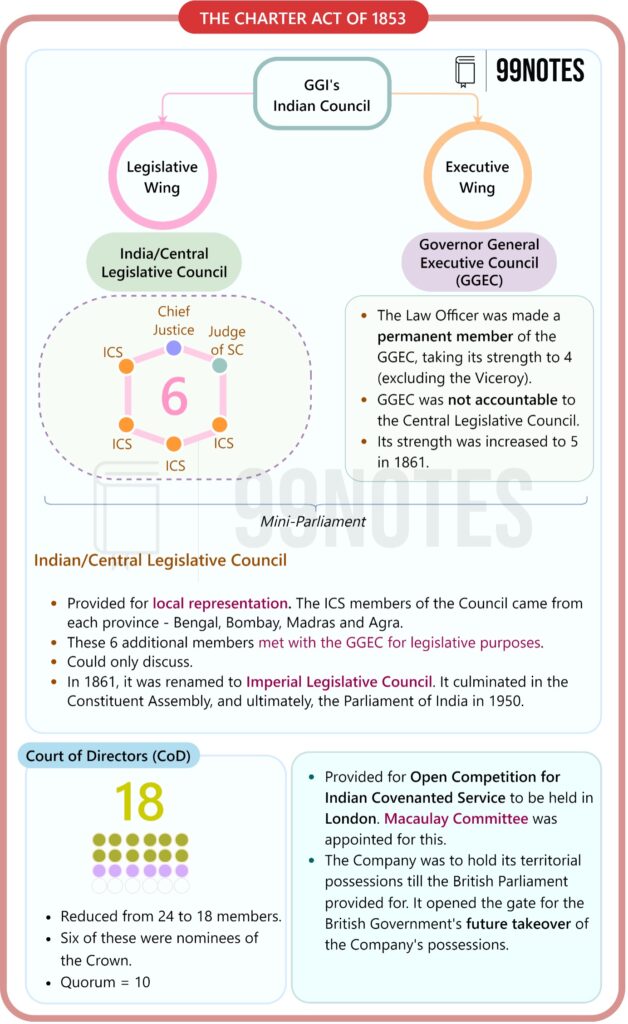

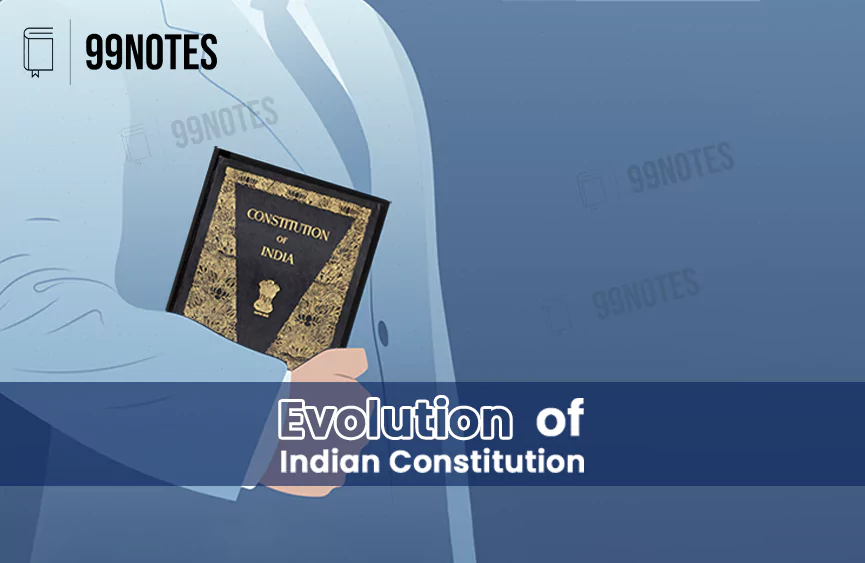


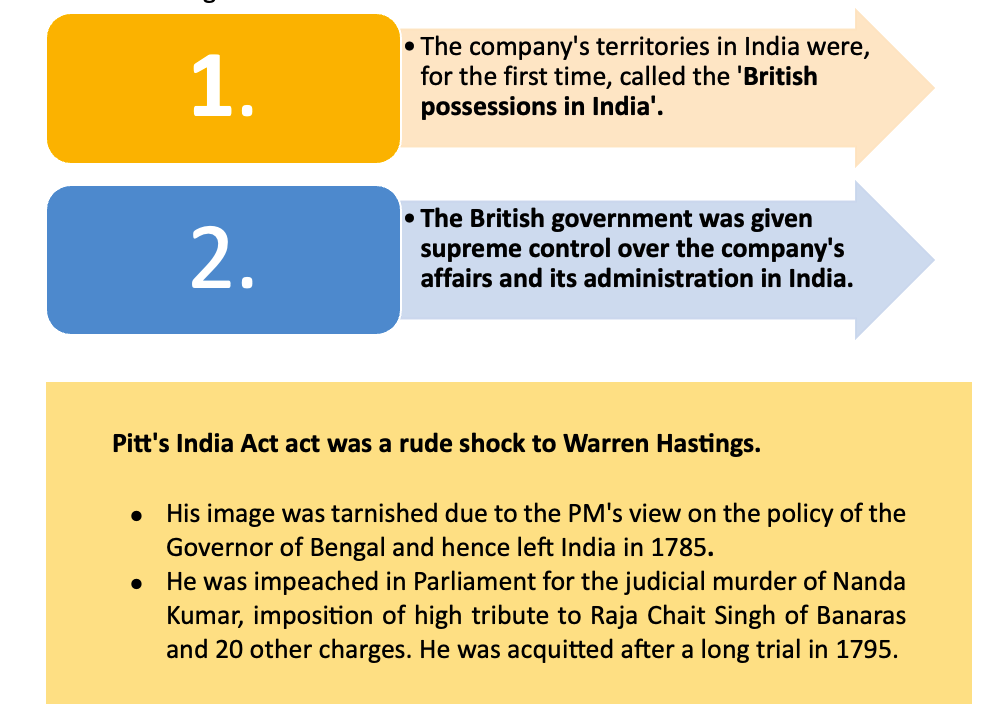
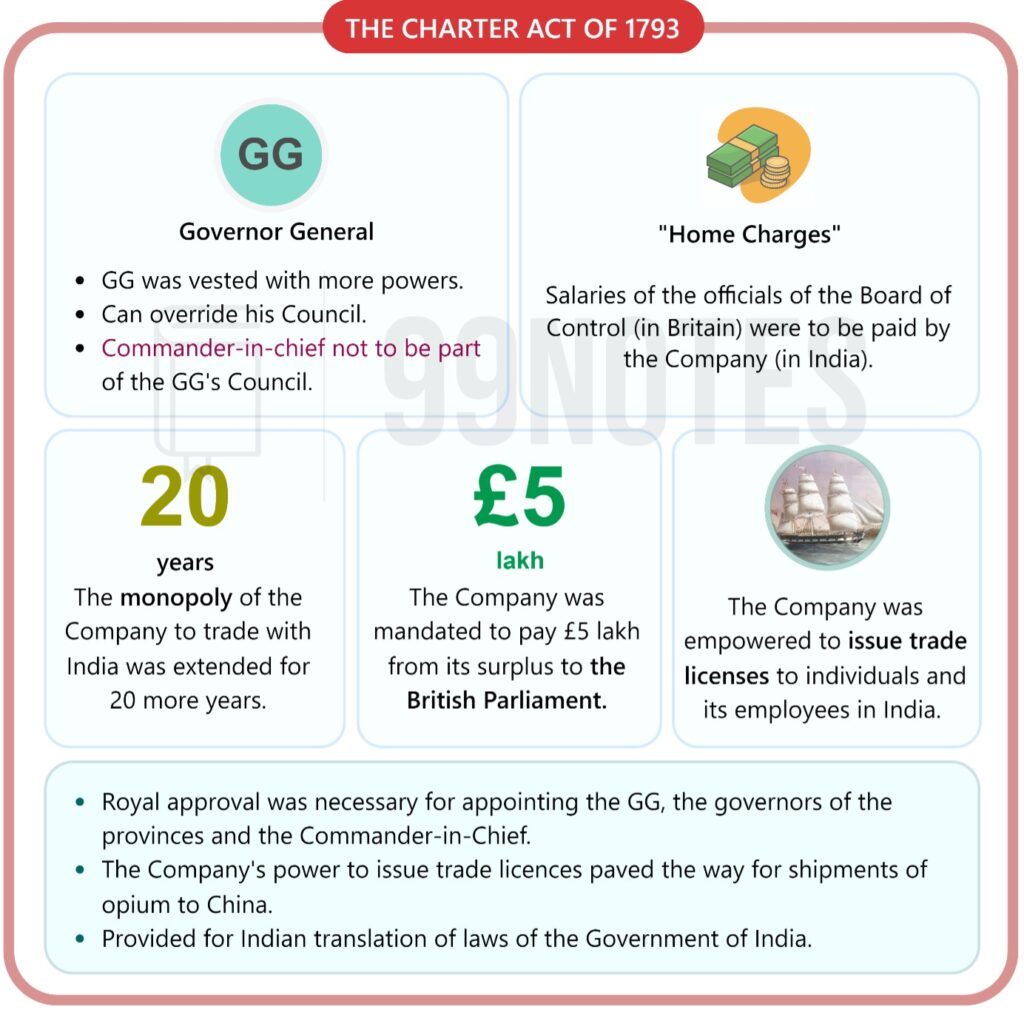
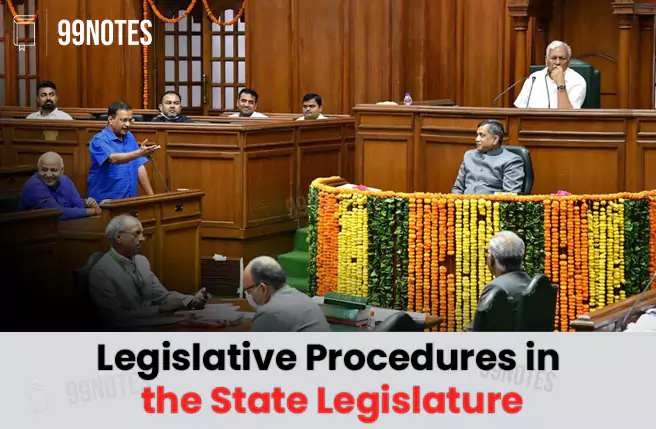
![Fundamental Rights Of Indian Constitution: Article12-35 [Indian Polity Notes For Upsc Exams] | Updated July 27, 2024 Fundamental Rights Of Indian Constitution: Article12-35 [Indian Polity Notes For Upsc Exams]](https://99notes.in/wp-content/uploads/2023/09/fundamental-rights-banner-99notes-651fdb2e2cee1.webp)


